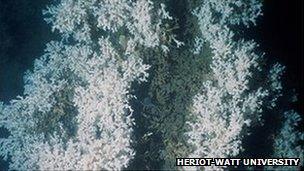Underwater robots to 'repair' Scotland's coral reefs
- Published

The robots will have built-in video and image-processing tools
Underwater robots tasked with saving coral reefs are being developed at Heriot-Watt University in Scotland.
Dubbed "coralbots", they are being designed to work in groups, in a similar manner to bees and ants.
The team is still "training" the software that will control the bots to "recognise" corals and distinguish them from other sea objects.
Corals are easily damaged by pollution and destructive fishing practices, and it takes decades for them to re-grow.
They are colonies of tiny living organisms, most commonly found in warm shallow waters in the tropics.
But the depths of the Atlantic Ocean off the west coast of Scotland are home to cold-water reefs.
When they get damaged, scuba divers re-cement broken fragments, helping them re-grow - but it is tricky for divers to reach depths over 200m.
Coralbots, the researchers hope, will be a lot more efficient, able to repair the reefs in days or weeks.
The team, which consists of a marine biologist, an artificial intelligence scientist, a roboticist, and a machine vision scientist, said it was trying to raise £2m to hold a first demonstration.

It is much harder for divers to reach deep water corals to repair them
The scientists said that if they got all the cash they needed, the bots could be embark on their first mission within a year.
Swarms of bots
Initially, the robots would be adaptations of those already developed at the university's Ocean Systems Lab.
They would be about a metre long, with built-in video, image-processing and simple manipulation tools, such as scoops and arms, and would operate in "swarms".
Swarming in nature is collective action of a large number of agents that are individually stupid but collectively can complete complex tasks.
Besides insects, birds and fish also swarm, as well as the smallest and simplest micro-organisms, such as bacteria.
"Our key idea is that coral reef restoration could be achieved via swarm intelligence, which allows us to exploit co-operative behaviours we see from natural swarms of bees, termites and ants that build complex structures such as hives and nests," said marine biologist Lea-Anne Henry who is lead scientist on the project at Heriot-Watt.
She said the robots would be intelligent enough to navigate and avoid obstacles.
"We are developing new intelligent object recognition routines, exploiting the data from hundreds of coral reef images, to enable each swarm member to recognise coral fragments and distinguish them from other materials and objects in the environment in real-time," she said.
One AI expert not involved in the project called it "very worthwhile".
"I think they have a very good chance of being successful," Prof Noel Sharkey of the University of Sheffield told the BBC.

The Mingulay reef complex in Scottish waters was discovered in 2003
"And it's an ideal task for swarm robotics. Look at termites - a termite follows a simple rule, pushing a little ball of dirt until it meets another ball of dirt. And you end up with these huge mounds that termites build and live in.
"It's the same here - these robots will have micro-rules, and even though each robot is dumb, collectively they will move and do something - and in the end, a reef will be repaired."
Corals in danger
A quarter of all marine life on the planet inhabits corals, according to the World Wildlife Fund.
In coastal areas, they also provide an important barrier against natural disasters such as storms, hurricanes, and typhoons.
There are fears that coral reefs may begin to disappear within 50 years.
Besides destructive fishing practices, other contributing factors are careless tourism and carbon dioxide emissions that make seawater more acidic, leading to the death of key coral species.
- Published15 May 2012
- Published23 July 2012
- Published26 January 2011